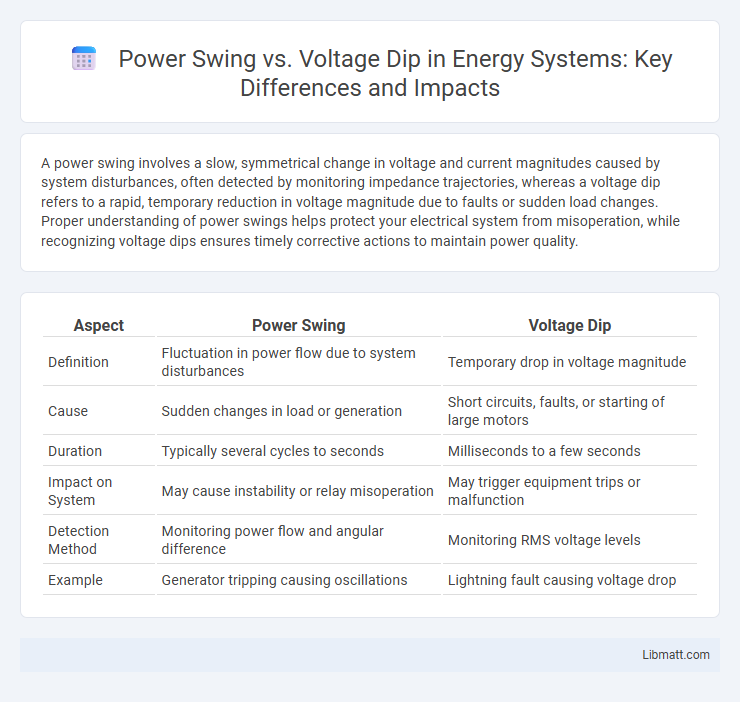A power swing involves a slow, symmetrical change in voltage and current magnitudes caused by system disturbances, often detected by monitoring impedance trajectories, whereas a voltage dip refers to a rapid, temporary reduction in voltage magnitude due to faults or sudden load changes. Proper understanding of power swings helps protect your electrical system from misoperation, while recognizing voltage dips ensures timely corrective actions to maintain power quality.
Table of Comparison
| Aspect | Power Swing | Voltage Dip |
|---|---|---|
| Definition | Fluctuation in power flow due to system disturbances | Temporary drop in voltage magnitude |
| Cause | Sudden changes in load or generation | Short circuits, faults, or starting of large motors |
| Duration | Typically several cycles to seconds | Milliseconds to a few seconds |
| Impact on System | May cause instability or relay misoperation | May trigger equipment trips or malfunction |
| Detection Method | Monitoring power flow and angular difference | Monitoring RMS voltage levels |
| Example | Generator tripping causing oscillations | Lightning fault causing voltage drop |
Introduction to Power Swing and Voltage Dip
Power swing refers to the dynamic fluctuations in electrical power flow within a transmission system due to sudden changes in load or generation, causing variations in voltage magnitude and phase angle. Voltage dip, also known as voltage sag, is a short-duration reduction in voltage level typically caused by faults, motor starts, or temporary overloads, resulting in momentary undervoltage conditions. Understanding the distinction between power swings and voltage dips is critical for grid stability, as power swings affect system synchronization while voltage dips impact sensitive equipment performance.
Defining Power Swing: Causes and Characteristics
Power swing occurs when synchronous generators experience abrupt load changes or system faults, causing gradual voltage fluctuations and phase angle shifts across transmission lines. Unlike voltage dips, which are rapid reductions in voltage magnitude caused by short circuits or sudden load additions, power swings involve slower voltage changes due to alterations in system power flow and generator rotor dynamics. Key characteristics include symmetrical and sustained voltage variations, often detected by distance relays to prevent false tripping during transient stability events.
Understanding Voltage Dip: Triggers and Effects
Voltage dips, also known as voltage sags, occur when the RMS voltage decreases for a short duration, typically caused by sudden increases in load or faults in the power system. Common triggers include motor startups, short circuits, and lightning strikes, which can lead to temporary instability in electrical equipment. These dips can disrupt sensitive devices, causing malfunctions, data loss, or reduced operational efficiency, highlighting the importance of managing power quality in electrical networks.
Key Differences Between Power Swing and Voltage Dip
Power swing refers to a gradual and large change in system voltage caused by load changes or system faults, while voltage dip is a sudden and brief reduction in voltage magnitude, typically caused by short circuits or fault conditions. Power swings maintain voltage stability despite fluctuations, whereas voltage dips can trigger protective equipment and cause sensitive devices to malfunction. Understanding these differences helps you optimize protective relay settings and improve system reliability.
Power System Stability During Power Swings
Power swings represent gradual changes in power system phase angles caused by disturbances, critical to maintaining system stability during transient events. Voltage dips, characterized by a sudden drop in voltage magnitude, often occur due to faults but do not necessarily impact rotor angle stability immediately. Distinguishing power swings from voltage dips is essential for protective relays to prevent unwarranted tripping and ensure continuous system operation under stressed conditions.
Impact of Voltage Dips on Sensitive Equipment
Voltage dips cause short-term reductions in voltage levels that can disrupt the operation of sensitive equipment such as computers, medical devices, and industrial controls, leading to malfunctions or data loss. Power swings, while involving voltage and frequency fluctuations, are typically slower and less likely to instantly damage sensitive devices but may trigger protective relays causing interruptions. Effective monitoring and mitigation strategies are essential to prevent voltage dips from causing hazardous failures in sensitive electronic systems.
Detection and Monitoring Techniques
Power swing detection relies on monitoring impedance variations using distance relays equipped with adaptive settings to differentiate between fault conditions and power swings, enhancing grid stability. Voltage dip detection involves analyzing voltage magnitude and duration through advanced sensors and phasor measurement units (PMUs) to identify transient disturbances affecting power quality. Your monitoring system benefits from integrating real-time data analytics and machine learning algorithms to improve accuracy in distinguishing power swings from voltage dips.
Protection Schemes Against Power Swing and Voltage Dip
Protection schemes against power swings and voltage dips primarily involve distance relays with power swing blocking and voltage dip detection features to prevent unnecessary tripping during stable but fluctuating system conditions. Power swing blocking schemes use impedance trajectory monitoring to distinguish between fault conditions and stable swings, ensuring relay operation only in genuine faults. Voltage dip protection integrates sensitive voltage magnitude checks and adaptive settings to quickly detect voltage sags, safeguarding your electrical system from sustained low-voltage disturbances.
Mitigation Strategies and Preventive Measures
Power swing mitigation relies on advanced protection relays with adaptive algorithms designed to differentiate between actual faults and power swings, preventing unnecessary tripping. Voltage dip prevention focuses on maintaining grid stability through dynamic reactive power compensation and robust voltage regulation using devices like STATCOMs or SVCs. Both scenarios benefit from real-time monitoring systems and coordinated relay settings to enhance system resilience and reduce disturbance impact.
Conclusion: Ensuring Reliable Power System Performance
Power swings and voltage dips both impact power system stability but differ in origin and response requirements; power swings result from large disturbances causing fluctuations in power flow, while voltage dips are short-term reductions in voltage magnitude. Understanding these phenomena enables you to implement precise protective relays and control strategies that quickly isolate issues without unnecessary outages. Ensuring reliable power system performance depends on accurately detecting and mitigating both events to maintain voltage stability and prevent cascading failures.
Power swing vs Voltage dip Infographic

 libmatt.com
libmatt.com